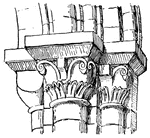
Joseph Habersham
(1751-1815) He served in the Revolution as lieutenant Colonel in the Georgia Continental Lines

Fencing
Quarte parry. The thrust in quarte for the left side of the body, on the high lines, is parried…

Fencing
Tierce parry. The thrust in tierce for the right side of the body, on the high lines, is parried…
Visual Illusion: Sloping Lines
If you fix your eyes on the two white spaces between the lines it will appear as if the top space becomes…

Visual Illusion: Line Length
Which line is longer? The black line on the right appears longer than the line beside it, but both lines…

Facial Angles
The facial angle is an angle formed by two imaginary lines; one drawn fom the most prominent part of…

Battle of Pittsburg Landing
Recapture of artillery by the First Ohio and other regiments under General Rousseau, April 7, 1862.…

Major Taylor
"Escorting Major Taylor, of New Orleans, the bearer of a flag of truce, blindfolded, to the Confederate…

Storming of Fort Donelson
"Storming of Fort Donelson- decisive bayonet charge of the Iowa Second Regiment on the Confederate intrenchments…

Battle of Pea Ridge
"Battle of Pea Ridge, Ark., fought March 6th, 7th and 8th, 1862, between the Federal forces, 13,000…
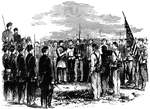
Seventy-ninth Regiment
"Taking away the colors of the Seventy-ninth New York Regiment for insubordination and mutiny, Washington,…

Battle at Willis Church
"Battle at Willis Church, Monday, June 30th, 1862- the Federal forces, under General Heintzelman, engaged…

James Island
"Repulse of the Confederates at James Island, near Charleston, S. C., June 10th, 1862, in the attempt…

Village of Clarksburg
"Village of Clarksburg, Western Virginia, headquarters of General Rosecrans. Clarksburg, a post village,…

Sea Bear
"It is the size of a large bear; girth at the sholder, five feet, near the tail, twenty inches; fur…

Fort Hindman
"The investment of Fort Hindman, Arkansas Post, Ark., by the Federal troops under General McClernand,…

Attack on Confederate Works
"Siege of Vicksburg, attack on the Confederate Works, May 22nd, 1863. Our sketch represents the terrible…

Battle of Gettysburg
"Battle of Gettysburg, Thursday evening, July 2nd, 1863, as seen from Rocky Hill, on Meade's left. Our…
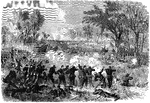
Battle of Chancellorsville
"Battle of Chancellorsville, Sunday, May 3rd, 1863. General Hooker repulsing the attack of the enemy.…
Government Buildings - Contraband Camp
"Government buildings for 'Contrabands,' erected at Hilton Head, S. C., in 1862. Among the many singular…

Hand-to-hand Combat
"Desperate hand-to-hand combat between Federal cavalry, commanded by General Averill and the daring…

Grant's Campaign
"Grant's Campaign in Virginia. The Battle of Bethesda Church, between Crawford's division, Fifth Corps,…

War in Virginia
"The war in Virginia. General Butler's lines south of the James, Va., with troops in position near the…

Capture of Lost Mountain
"The war in Georgia. Capture of Lost Mountain by General Hooker, June 16th, 1864. On June 14th General…

Battle of Ream's Station
"The Siege of Petersburg. Battle of Ream's Station- the attempt of the enemy to regain the Weldon Railroad…

Battle of Bentonville
"The Battle of Bentonville, N. C.- Major General Mower, commanding First Division, Seventeenth Corps,…

Buzzard's Roost
"Sherman's Campaign. The capture of Buzzard's Roost at Hovey Gap, Ga., May 8th, 1864. Among the strongholds…
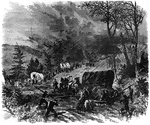
Campaign in Georgia
"The campaign in Georgia. A baggage train crossing the mountains in a storm. General Sherman, after…

Jackson Hill
"Sheridan's campaign in the valley of the Shenandoah- view of the front from the Federal lines on Jackson…
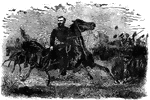
General Sheridan
"Major General Sheridan riding along the lines after the Battle of Fisher's Hills, Va., September 22nd,…

Battle of the Wilderness
"The battle of the Wilderness, between General Grant and General Lee, May 5th and 6th, 1864. Our sketch…

Eider Ducks
The eider duck is found throughout the northern regions of Europe and North America. The female lines…

Union Terminal
Cross Section of umbrella train shed, showing clearance lines, Union Terminal, Washington, D.C.

Red Gurnard
"Twelve to sixteen inches long; it feeds on curstaceous animals; spawns in May or June; it is esteemed…

Sapphire Gurnard
"Is two feet long, and is common in the Mediterranean and other European waters; its flesh is good,…

Gilt-Head
"Twelve inches long, abundant in the Mediterranean, and found on the coasts of Africa and Europe, from…
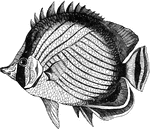
Wandering Chaetodon
"Twelve inches long, body of a pale yellow color, with numerous oblique, brownish-purple lines. Inhabits…

Van Wart's Monument
"Van Wart's monument. The following are the inscriptions upon this monument: North Side: 'Here repose…

Battle at Willis Church
"Battle at Willis Church, Monday, June 30th, 1862- the Federal forces, under General Heintzelman, engaged…
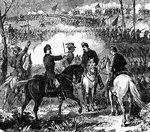
Battle of Pea Ridge
"Battle of Pea Ridge, Ark., fought March 6th, 7th and 8th, 1862, between the Federal forces, 13,000…

Battle of Pea Ridge
"Battle of Pea Ridge, Ark., fought March 6th, 7th and 8th, 1862, between the Federal forces, 13,000…
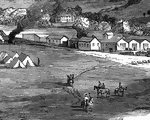
Village of Clarksburg
"Village of Clarksburg, Western Virginia, headquarters of General Rosecrans. Clarksburg, a post village,…
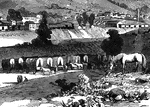
Village of Clarksburg
"Village of Clarksburg, Western Virginia, headquarters of General Rosecrans. Clarksburg, a post village,…

Battle of Chancellorsville
"Battle of Chancellorsville, Sunday, May 3rd, 1863. General Hooker repulsing the attack of the enemy.…
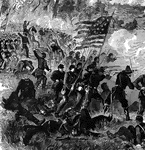
Battle of Chancellorsville
"Battle of Chancellorsville, Sunday, May 3rd, 1863. General Hooker repulsing the attack of the enemy.…
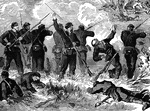
Battle of Chancellorsville
"Battle of Chancellorsville, Sunday, May 3rd, 1863. General Hooker repulsing the attack of the enemy.…

Accidental Point
"That point in which a right line drawn from the eye parallel to another given right line cuts the picture…

Buffalo
"The Buffalo. As the game upon which they depended moved about the country, so the Indians roved in…

Hale Statue
"Statue of Nathan Hale. It was during his treated that an event occurred which showed how much Americans…
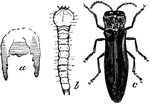
Agrilus
"Agrilus ruficollis. a, anal end of body of larva; b, larva; c, beetle. (The vertical lines show natural…

Garden-spiders
"Some, of which the Common Garden Spider, Epeira diadema is an excellent example, construct…

Sea-urchin without spines
"The globular crest of this animal is made up of several hundred polygonal pieces of different sizes,…
Cross-section from a shaft of a long bone
"Little openings (Haversian canals) are seen, and around them are arranged rings of bone with little…
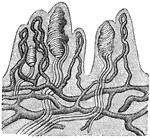
Papillae of the skin
"In each papilla are seen vascular loops (dark lines) running up from the vascular network below; the…
Portion of a medullated nerve fiber
"The axis cylinder is in the center. On either side is seen the medullary sheath, represented by dark…
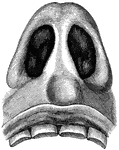
Nasal cavities
"Nasal Cavities, seen from Below. The sense of smell is located in the membrane which lines the cavities…

Palmistry
"Palmistry, or Chiromancy, is the art which professes to discover the temperament and character of anyone,…

Carpentum
"A cart; also a two-wheeled carriage enclosed, and with an arched or sloping cover overhead. The carpentum…
